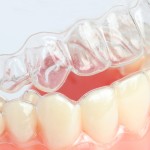
While the first clear aligner was introduced in the 1940s it is only in recent past that there has been a significant rise in their use. The improved aesthetics of this type of appliance is one of its main advantages although initially costs are higher and certain malocclusions cannot be treated. Despite their popularity there are concerns that the available literature may be limited to case reports and series.
The aim of this review was to assess the efficiency, effectiveness and stability of treatment outcome with clear aligners compared with treatment with conventional brackets.
Methods
Searches were conducted in the Cochrane Oral Health Group’s Trials Register, Scopus, CENTRAL, Medline, Embase, Web of Science and Google Scholar databases. This was supplemented by a manual search of the journals, American Journal of Orthodontics and Dentofacial Orthopaedics, European Journal of Orthodontics, Angle Orthodontist, Journal of Orthodontics and World Journal of Orthodontics and the bibliographies of included papers. Pro and retrospective original studies on patients involving treatment with clear aligners were considered.
Two reviewers independently selected studies abstracted data and assessed study quality. Meta-analysis was undertaken where studies reported the same outcome measures.
Results
- 4 studies (1 RCT and 3 cohorts) involving a total of 270 patients were included.
- 3 studies (1 RCT and 2 cohorts) compared total treatment time and meta-analysis suggests duration is longer with conventional brackets, Standard mean difference = -0.51 (95%CI; -1.29 to 0.26).
- 1 cohort study (150 patients) suggested chair time, visits and emergency chair time was shorter with aligner treatment.
- 1 cohort study (48 patients) found that Invisalign® did not treat malocclusion as well as conventional braces when assessed using The American Board of Orthodontics Objective Grading System (OGS).
- Another cohort study (48 patients) found larger post-retention changes with Invisalign® than conventional brackets.
Conclusions
The authors concluded: –
Despite claims about the effectiveness of clear aligners, evidence is generally lacking. Shortened treatment duration and chair time in mild-to-moderate cases appear to be the only significant effectiveness of clear aligners over conventional systems that are supported by the current evidence.
Comments
We last looked at a review of this topic in 2014 (Dental Elf – 24th Nov 2014). As with the 2014 review this new review has conducted an extensive database search and including only 4 small studies involving a total of 270 patients. The 2014 review included 11 studies involving 484 patients.
Despite the differences between the reviews the conclusion that is readily drawn from both is that there is insufficient high quality evidence to support the effectiveness of clear aligners. Consequently, there is a need for well-conducted and reported high quality randomised controlled trials to provide clarity for clinicians and patients of the advantages and disadvantages of clear aligner treatment.
Links
Primary paper
Zheng M, Liu R, Ni Z, Yu Z. Efficiency, effectiveness and treatment stability of clear aligners: A systematic review and meta-analysis. Orthod Craniofac Res.2017 May 26. doi: 10.1111/ocr.12177. [Epub ahead of print] PubMed PMID: 28547915.
Other references
Dental Elf – 24th Nov 2014
Orthodontic aligners: little evidence to assess their effectiveness
